The North Lancashire Loop line, also widely known as the Great Harwood Loop or the Padiham branch, was a railway line which diverged from the East Lancashire line just outside Blackburn at its Western end, passed through the town of Great Harwood, rural Simonstone, then onwards to the town of Padiham, finally reconnecting with the East Lancs line at Rose Grove (near Burnley) in the East.
The line had three stations as mentioned above and was reportedly the most expensive line per mile the L&Y (Lancashire and Yorkshire Railway Company) ever built; in length it was just 9 miles long and passed through some beautiful countryside.
BEGINNINGS
The East Lancs. Line, originally built in the 1840s, missed out the towns of Great Harwood and Padiham, which caused great inconvenience to local industry and the population in general. By the early 1860s there were calls from many in the area to have a line of their own, and in 1865 the Manchester & North Lancashire railway company (M&NL), headed by some very powerful landowners, announced they were going to build the line, along with some other ones, and sent a Bill to Parliament.

The L&Y put up fierce opposition to this proposal as it was in their area and sent a Bill of their own two days later. A deal was done and £9,000 was paid to the M&NL to withdraw its Bill, which they did. In return the L&Y promised that they would build the line as soon as possible. The L&Y’s Act was passed in 1866, but as soon as that happened they then applied for an extension of time to complete the line.
The Local Board at Great Harwood held an extraordinary general meeting on Monday 4th March 1867 and a motion was passed to petition Parliament in opposition to this extension of time, stating that they didn't think the L&Y needed six years to build such a line. One member present called the L&Y “like a dog in a manger” – “they would not let another company build the line, nor build it themselves”.
CONSTRUCTION AND DELAYS
It took what must have seemed four long years before the L&Y actually started to build the railway. They started at Great Harwood in April 1870. The problem with this line was that from Blackburn to the River Calder via Great Harwood it was almost all downhill. Three cuttings had to be dug out at Cunliffe near Blackburn, at Norden on the edge of Rishton, and one at the approach to where Great Harwood station was going to be. These cuttings were to the west of Great Harwood.
 19461:10560 (6") OS map showing Padiham Junction and Rose Grove MPD
19461:10560 (6") OS map showing Padiham Junction and Rose Grove MPD
If that wasn't bad enough, the 680,000 cubic yards of soil, clay and rock from the cuttings then had to be moved to the eastern end of Great Harwood, because from here two miles of embankments were needed all the way down to the River Calder and beyond. At the River Calder, the embankment was around 65 feet high and the base was around 270 feet wide. The walls of the cuttings repeatedly caved in and the embankments repeatedly slipped and subsided. It's reported that the engineer said the embankment next to the viaduct was (at one point) subsiding 4 feet a day. Because of these delays, it was to take the L&Y seven years to complete the line, and 11 years from the original passing of the Act.
At some point, I think the L&Y must have regretted even the notion of building this line.
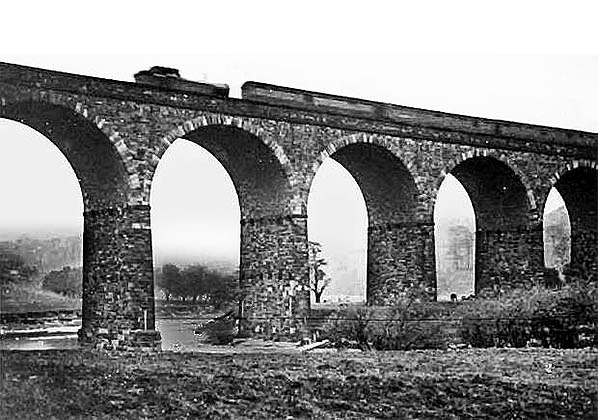 A Barton-Wright 0-6-2 tank engine pulls a train across Martholme viaduct heading west on the up line for Great Harwood and Blackburn in 1920.
A Barton-Wright 0-6-2 tank engine pulls a train across Martholme viaduct heading west on the up line for Great Harwood and Blackburn in 1920.
Photo from John Mann collection
At the River Calder, the line was crossed by Martholme viaduct, a ten arch stone bridge carrying the line 65 feet above the river. Here, where the bridge was to be built, lay coal at the base. There were concerns that a stone bridge would collapse if this coal were to be extracted, which led to a decision to build the bridge from wood. However a couple of weeks later the rights to mine the coal were bought for £1,800 from James Lomax, Lord of the Manor at Great Harwood, the coal remained in the ground and the viaduct was then constructed of stone as originally intended.
After the viaduct, the line levelled out to Simonstone, and then one mile further to Padiham. The Padiham to Rose Grove section was straightforward by contrast, although the line had to go uphill at a steep gradient of 1 in 40, known as the ‘Padiham bank’.
Given the difficulties west of Padiham, it's no surprise that the section from Padiham to Rose Grove opened before the rest of the line, which it did to goods on 1st July 1875 and for passengers on 1st September 1876. It was decided that celebrations would be put on hold until the whole line was open.
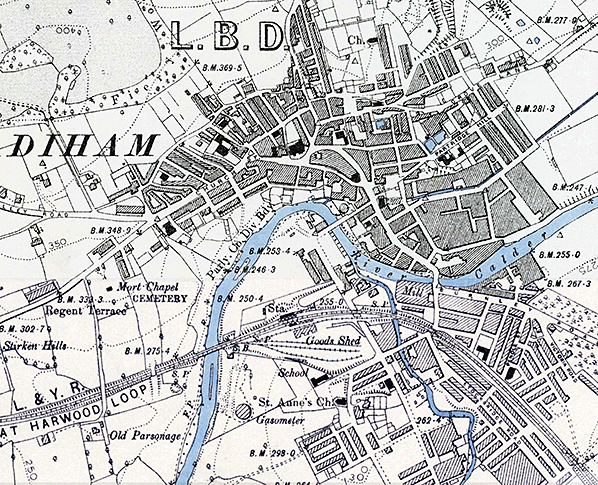 1895 1:10560 (6") OS map of Padiham. Click here for a larger version
1895 1:10560 (6") OS map of Padiham. Click here for a larger version
FATAL ACCIDENT
Sadly, during the construction of Britain's railways in the 19th Century many people were killed, and the loop line was no exception; at least one is known about. On Friday afternoon 22nd of September 1876, a labourer working with other men filling ballast railway wagons with earth near Great Harwood station was killed when he tried to jump on one of the moving wagons and fell between the tracks. Two wagons passed over him without injury, but whilst trying to escape he was run over by a third one. His injuries were so severe that he died later on Saturday morning at 3:30 am.
MORE DELAYS
In January 1877, the embankment next to Great Harwood station at Duxbury Wood suffered a landslip; it took with it the 55 foot embankment, track and signals. It was to take six months to rebuild and make repairs just prior to the line's opening.
THE FULL LINE OPENS
The line west of Padiham was opened on 1st June 1877 to goods trains only, the idea being that the heavier goods trains would help to consolidate the embankments.
On 28th September 1877 General Hutchinson on behalf of the Board of Trade (BOT) inspected the line and ran some safety tests including two 40 ton engines to test the bridges, and released a wagon from Great Harwood goods yard (going downhill) to see if a runaway vehicle would reach Simonstone station. The wagon stopped half a mile away from Simonstone on the level section.
 1895 1:10560 (6") OS map showing Simonstone and the station
1895 1:10560 (6") OS map showing Simonstone and the station
The BOT granted the certificate on 3rd October 1877 and the first passenger train ran on Monday 15th October 1877, two days earlier than advertised. To celebrate this and to say thank you to the station master at Rishton, the ‘Great and the Good’ of Great Harwood presented him with a gold watch and chain at an evening meal. Before the line opened, all goods coming in or going out of the town by train had to be carted to and from Rishton station on the East Lancs. line.
The loop line had cost almost £300,000 to build; however the week following the line's opening the L&Y's receipts were up by way over £1,000.
One important reason for building the loop line was that it could (and was) used as a diversionary line, bypassing Accrington station on the East Lancs. Line. Accrington was a very busy junction station, as it also served an important route towards Bury and Manchester and the extra traffic that came from that direction.
SIGNAL BOXES
At the western end, Great Harwood Junction signal box, just outside Blackburn, guarded the entrance to the line, whilst Rose Grove West box controlled access at the eastern end. Originally the line had 8 signal boxes, Padiham (East & West), Simonstone, Martholme Colliery, Great Harwood (East & West), Norden (Rishton), Queen Brick Sidings (near Blackburn). Only 4 of them survived to the end.
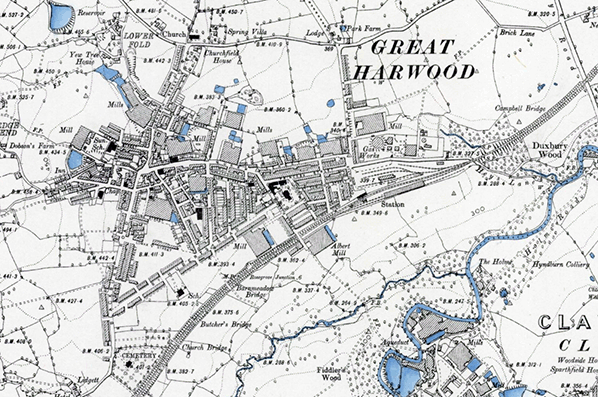 1895 1:10560 (6") OS map of Great Harwood. Click here for a larger version
1895 1:10560 (6") OS map of Great Harwood. Click here for a larger version
GRADIENTS
The gradients for the line were as follows, running from Blackburn eastwards, it was uphill for 1.5 miles with a 1 in 64 and a 1 in 59 incline. From here it was all downhill to the river Calder. Starting with a 1 in 90 for roughly 1.25 miles and a 1 in 196 at Great Harwood station, it then fell sharply to a steep 1 in 52 as the viaduct approached. Across the viaduct it was level until about 0.5 miles from Padiham. The line here climbed a 1 in 100 and then level again at Padiham station. Coming out of Padiham the line climbed the 1 in 40 bank for 1.25 miles up to Rose Grove West junction (Padiham junction).
STATION DISTANCES
Travelling east from Blackburn, Great Harwood was 4.5 miles away, Simonstone 7.5 miles, Padiham 8.5 and Rose Grove 10 miles. A typical passenger train in 1882 from Blackburn to Rose Grove would take 26 minutes.
STATION CLOCKS
For those who are interested in horology, John Agar supplied the original platform clock at Padiham. He (and his son also called John) supplied the L&Y with many clocks and pocket watches. It is highly likely that he also supplied Great Harwood and Simonstone stations with their clocks, but it isn't proven.
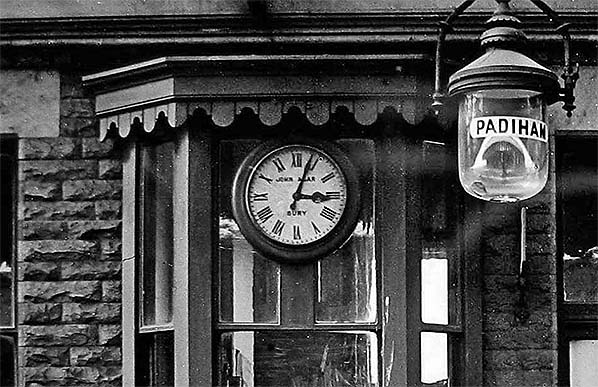 The John Agar clock in front of the station master's office at Padiham station c. early 20th century.
The John Agar clock in front of the station master's office at Padiham station c. early 20th century.
Photo from John Mann collection
A NEW LOCOMOTIVE WORKS
In the early 1880's the L&Y were planning to build their new locomotive works at Great Harwood, however James Lomax, Lord of the Manor in the area refused to sell the land, and it was built at Horwich instead.
RUNNING ALONG THE LINE
Although the following details are taken from the BR 1960 sectional appendix, they are unlikely to have changed much over the years. Passenger trains could reach 60 mph. and goods 30 mph.
Working west from Rose Grove, a passenger train was allowed to run at full speed down the 1 in 40 bank towards Padiham; however the speed had to fall to 25 heading towards the tight left hand curve into the station. The fireman would have to be thinking about the climb up from here to Great Harwood. Out of Padiham full speed was again allowed but it would be unlikely as Simonstone was only 1 mile away. From Simonstone, full speed again but there was a 50 limit approaching the curve up to and over Martholme viaduct. Once the viaduct was cleared you now have the climb up to Great Harwood and again full speed was unlikely. The climb continued past Harwood until near Great Harwood junction from where it was downhill and the fireman could relax a little.
MARTHOLME COLLIERY
Between Great Harwood and Martholme viaduct (on the west side of the viaduct) was Martholme colliery, 0.25 miles away from the viaduct itself. An agreement in August 1894 was signed with the L&Y and here sidings were built either side of the running lines, and a connection to the colliery itself in 1895. In the 1890's 200 miners worked there. Martholme signal box was built at the same time as the sidings and was between the up line and the up siding close to the entrance to the colliery. The box itself was built of wood. Wagon movements between the sidings and the colliery were done with a horse.

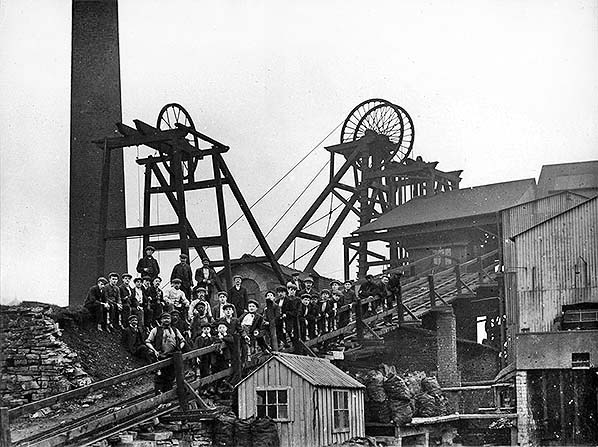
Photo from Lancashire Telegraph
A NEW FOOTBRIDGE:
On 30 March 1896 a new footbridge was opened to connect both sides of Pendle Street over the line, in the town of Padiham. It was commissioned by the town council after several years of discussion. Sir Ughtred Kay-Shuttleworth MP for Gawthorpe kindly donated £200 for its construction.
USE OF THE LINE:
The line’s use was typical for a branch line of that era, with both passenger and freight trains using it. The freight consisted of general goods, food, parcels, cattle, cotton, mail, and coal: lots of coal. For a large part of its history, because of the steep 1 in 40 climb from Padiham to Rose Grove, it was common for an engine to be based at Padiham daily from Rose Grove engine shed to help with banking duties – that is, to help push the trains up the gradient.
Any freight trains routed to go down the bank from Rose Grove to Padiham had to stop near Rose Grove West signal box and pin down some of the wagon brakes before travelling down to Padiham. At Padiham, the train would stop again at the station and release the wagon brakes before continuing.
Both signal boxes (East and West) at Padiham closed in 1913 and were replaced by a single one situated on the down platform at the eastern (Rose Grove) end.
In 1921 during the national coal strike, Martholme colliery became flooded and had to close with the loss of 350 jobs. This saw the end of any coal traffic from this colliery.
Norden signal box near Rishton, closed 24th November 1922.
 1895 1:10560 (6") OS map of Harwood Junction
1895 1:10560 (6") OS map of Harwood Junction
THE LMS PERIOD (1923-1947)
During the LMS (London, Midland & Scottish Railway) period the passenger timetable seems to have remained more or less the same as in the L&Y days, with slightly fewer passenger trains and two on Sundays. No photographs of the loop line are known of during the LMS period.
By the 1930's the gas works at Great Harwood had largely stopped producing gas from coal; instead it was mainly used as a gas storage / purifying facility. As a result, coal and coke traffic to the gas works dried up.
On the 17th November 1937, Martholme signal box at the former colliery site closed, and Queen brick sidings box (near Blackburn in the west) closed early to mid 1940's but there's no exact date for that.
During this period all three stations were given the LMS Hawkseye station name signs.
THE BR PERIOD (1948 and onwards)
During the British Railways (BR) period many heavy trains using the route would travel down the bank to Padiham when heading westwards towards Blackburn and Preston. Returning trains generally ran via the East Lancs. main line and passed through Accrington, although some through excursion trains did run to Rose Grove via the North Lancs Loop, requiring the usual banking engine at Padiham to do so, along with the usual empty coal trains from Padiham power station.
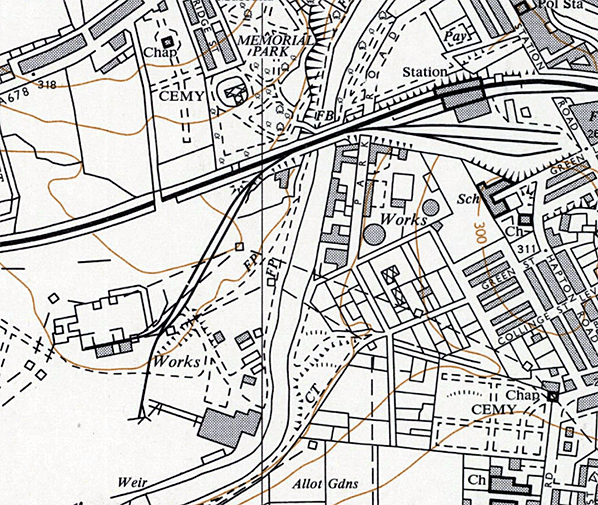
1965 OS map showing the site of Padiham power stations A and B. You can see both buildings towards the bottom left of the picture where it says 'Works'. ‘A’ was the original power station which started generating electricity in 1927, and was situated next to the River Calder. A private siding ran from directly from the loop line just west of Padiham railway station just after the lines crossed the River Calder bridge. ‘B’ was authorised in 1957 and by the early 1960s was also generating. The private sidings at the power station changed over time. Here in the 1965 map extra lines have been laid to supply the new ‘B’ station. A couple of years later, the reception siding and extra private sidings were re-laid parallel to the loop line between Padiham B and the main running lines which stopped before the A678. Padiham B had initial problems which caused the staff at the A station to call it "Padiham maybe...". It did however become a very efficient plant in its own right. It would have been a common occurrence for the people of Padiham to see the coal trains go down to the power station and empty wagons going back up to Rose Grove. 1965 was also the year the down (eastbound) loop line was lifted all the way to just west of Padiham railway station. Padiham A closed in 1969 and B in September 1993. Once the B station closed the line became unused
As listed in 1956, Great Harwood catered for general goods, passengers, parcels, livestock and horses (including prize cattle vans). Simonstone had general goods, passengers, parcels, and livestock, while Padiham catered for general goods, passengers, parcels, and horses, but not livestock.
 BR's Burnley area manager stands chatting to two steam enthusiasts in front of Black 5 (45110) at Rose Grove motive power depot (engine shed) 2 August 1968. This was right at the end of steam on Britain's railways, and people came far and wide to visit Rose Grove as it was one of only three engine sheds dedicated to steam left. In short, the place became very famous. It must be remembered that this engine shed was right at the eastern end of the North Lancashire loop line, just on the East Lancs line close to the station there. The engine 45110 took part in the fifteen guinea special rail tour, the last steam hauled main line tour before BR's steam ban came into force. 45110 pulled the special from Liverpool to Manchester where it was replaced with a Britannia class 70013 ‘Oliver Cromwell’. When the tour returned to Manchester, 45110 was re-attached for the last leg back to Liverpool. Rose Grove engine shed was right at the eastern end of the loop line on the East Lancs line and stood next to the junction for the loop line
BR's Burnley area manager stands chatting to two steam enthusiasts in front of Black 5 (45110) at Rose Grove motive power depot (engine shed) 2 August 1968. This was right at the end of steam on Britain's railways, and people came far and wide to visit Rose Grove as it was one of only three engine sheds dedicated to steam left. In short, the place became very famous. It must be remembered that this engine shed was right at the eastern end of the North Lancashire loop line, just on the East Lancs line close to the station there. The engine 45110 took part in the fifteen guinea special rail tour, the last steam hauled main line tour before BR's steam ban came into force. 45110 pulled the special from Liverpool to Manchester where it was replaced with a Britannia class 70013 ‘Oliver Cromwell’. When the tour returned to Manchester, 45110 was re-attached for the last leg back to Liverpool. Rose Grove engine shed was right at the eastern end of the loop line on the East Lancs line and stood next to the junction for the loop line
Copyright photo from the Burnley Civic Trust Heritage Image Collection
 Rose Grove engine shed in September 1961 with its new roof which was built sometime between 1947 and 1957. The shed had six roads leading into it. Here on one of them can be seen on the right a class 4P 2-6-0 tank engine. These tank engines were used for the local passenger trains in the area. A typical combination for a passenger train along the loop line was one of these tank engines and three carriages. Around this date, you would have seen a mixture of tank engines, Black 5's, Crabs, and Austerity 2-8-0 engines. The shed always had some larger engines like the 2-8-0 configuration as not only were they needed for the coal trains to Padiham power station but also to run the difficult Copy Pit route into West Yorkshire. In this photo, you can also see a diesel shunter. It was one of the three joint steam engine sheds to make it to the end of BR steam days. It was closed 5 August 1968. I read once that on the Sunday 4 August one driver retuned with his engine late in the evening only to find the shed had mostly been stripped by souvenir hunters (but that could just be a story). As a small boy one day, I passed the shed in the early 1970's. You could clearly see the now dark interior of the shed which looked completely abandoned and alone. Most of the former shed site is buried under the M65 motorway.
Rose Grove engine shed in September 1961 with its new roof which was built sometime between 1947 and 1957. The shed had six roads leading into it. Here on one of them can be seen on the right a class 4P 2-6-0 tank engine. These tank engines were used for the local passenger trains in the area. A typical combination for a passenger train along the loop line was one of these tank engines and three carriages. Around this date, you would have seen a mixture of tank engines, Black 5's, Crabs, and Austerity 2-8-0 engines. The shed always had some larger engines like the 2-8-0 configuration as not only were they needed for the coal trains to Padiham power station but also to run the difficult Copy Pit route into West Yorkshire. In this photo, you can also see a diesel shunter. It was one of the three joint steam engine sheds to make it to the end of BR steam days. It was closed 5 August 1968. I read once that on the Sunday 4 August one driver retuned with his engine late in the evening only to find the shed had mostly been stripped by souvenir hunters (but that could just be a story). As a small boy one day, I passed the shed in the early 1970's. You could clearly see the now dark interior of the shed which looked completely abandoned and alone. Most of the former shed site is buried under the M65 motorway.
Photo from Roger Griffiths collection
THE START OF THE CLOSURE - DECLINE
The line for most of its life was well used by passengers and freight, but by the early 1950s the passenger numbers were falling away due to road competition. Many of the Lancashire cottons mills were struggling to compete with cheaper imports and by the early 1960s one cotton mill a week was closing in Lancashire, which also led to a decline in freight traffic along the line.
Many of the remaining mills were switching from static steam engines which powered the looms over to electric motors, and as such they no longer required as much coal. The National Coal Board took over control of Britain's coal mines in 1947 and one by one, coal mines in the area started to close or became uneconomic to work. In short, the area was in decline.
THE RUMOURS START AND BR's TACTICS
In 1956, there were rumours BR (British Railways) were planning to close the line to passengers. BR denied this. However their notorious tactics came into play. This same year the electronics company Mullard was about to open a
new factory situated right next to Simonstone station.
The company asked BR if the 6.32am passenger train from Blackburn could run 10 minutes earlier to allow up to 400 employees to get to work at the new factory. BR refused, saying that it was not possible.
Not content with that, the very day the factory opened, BR withdrew the 6.32am train’s stop at Simonstone. All the other trains in the timetable, both before and after the 6.32am, continued to call there. BR never reinstated the Simonstone stop for this one train.

In February 1957, BR supplied Great Harwood station with the new totem signs, but only a month later made notice of its intent to close the line to passengers stating it was losing £10,000 per year.
Padiham was also supplied with the new signs but they were never installed.
The usual consultation meeting was held in Manchester and the public was invited to attend and state the case for keeping it open. It made no difference of course. BR was simply obliged to hold the meeting and had already made their mind up regardless of what anyone had to say.
By July 1957 the word was put around that BR would cancel the daily 20 passenger trains and shortly afterwards closure notices went up. The line was to continue with freight, diverted trains, and the local stations would open briefly in the summer for the town's ‘Wakes Week’ holidays, and bank holidays etc.
REGULAR PASSENGER TRAINS STOP
The line closed for regular passenger trains on 2nd December 1957, but the last actual train left Blackburn on a Saturday night, 30th November at 10.47 pm. Much play was to be had with the press as they noted there were only 6 passengers – not surprising on a cold, dark, late Saturday night in the middle of winter! At 10.50pm the last train from Rose Grove arrived at Blackburn: it is not known how many people were on it.
 A Hughes crab 42828 pulls the 1Z12 out of Great Harwood station heading west for Southport on a seaside day trip special. Here it is passing West signal box. The photo was taken 15 April 1963. The lamp room building is on the right just in front of the footbridge and station. The track on the right heads for the carriage shed and its sidings.
A Hughes crab 42828 pulls the 1Z12 out of Great Harwood station heading west for Southport on a seaside day trip special. Here it is passing West signal box. The photo was taken 15 April 1963. The lamp room building is on the right just in front of the footbridge and station. The track on the right heads for the carriage shed and its sidings.
Photo by Geoffrey Robinson from John Robinson's Steaming North Last days of the North East Lancs Loop Line collection
The stations at Great Harwood and Padiham (but not Simonstone) did indeed re-open (including the booking offices) for the Wakes Week town holidays, Whitsuntide, and Bank holidays in the late 1950s and early 1960s. These trains were very popular, with Blackpool being the typical destination, along with Southport, Fleetwood and Morecambe. Excursion trains stopping at Great Harwood (with more than five carriages) would have to draw forward to allow the passengers on or off due to the short platforms. Padiham had no such problem as it could cater for nine carriages.
Goods trains continued using the line, along with longer-distance holiday trains from places like Radford (Nottingham), Newcastle, Hull and West Yorkshire, empty stock trains from Colne, diverted trains, and light engines.

CLOSURE OF THE LINE WEST OF PADIHAM
1963 and Dr Beeching… He had no time for branch lines like this one and 1963 was the last year BR ran Wakes Week holiday trains or so I thought. Great Harwood's last Wakes Week holiday trains did indeed last run in 1963, but not for Padiham. A member of the LNER Encyclopedia website called Solario spotted a returning train to Padiham from Scarborough on 11 July 1964. It was the 1X05 pulled by Mirfield engine 44990 and he saw it passing his garden in Cottingham (between Beverley and Hull)
In 1964, just a little over one year after Dr Beeching's ‘The Reshaping of British Railways’ report
a closure meeting was held between BR management, staff and the NUR (National Union of Railwaymen) at Blackburn station on Wednesday 13th May 1964.
The minutes of the closure meeting reveal BR's plan: to close Great Harwood & Simonstone goods yards, to remove the Down (Eastbound) line from Blackburn to Padiham station, and to leave just 1 mile 55 chains (1.68 miles) at the eastern end of the route towards Rose Grove West junction.
The Up (Westbound) line was also to be removed in the same way as the Down line, leaving 1 mile 76 chains (1.95 miles) in order to be able to continue supplying Padiham power station with coal. The argument put by BR was that at Great Harwood the estimated loss would be £3,600 and the total savings brought by the closure would be £13,000. The figures were hotly debated. Management asked the staff if they would like more time to consider the figures given. The reply was “there was no point, the decision to close the line had already been made regardless of what they had to say”, and with that the meeting ended.
The line west of Padiham closed on 2nd November 1964. Originally this section was to close on 7th September, but a letter dated 4th September postponed closure to the later date with no explanation. However as the November date coincided with the last weekend of the Blackpool illuminations and the closure of Blackpool Central station, this is one possible reason why, but nobody really knows.
On closure, the signal boxes at Great Harwood (East and West) and Simonstone also closed. The coal traffic for Great Harwood was transferred to Blackburn, and coal for Simonstone was temporarily transferred to Padiham, which at some unspecified later date would in turn be transferred to Burnley.
The period from November 1964 to September 1965 is a strange one. All the infrastructure of the line was extant but there are no reports of any passenger movements along the now closed section. It is quite clear BR management were concerned about coping with summer holiday traffic after closure and it is very possible they ‘hedged their bets’, meaning that if needed, the line could be pressed back into temporary use during that summer of 1965. However, it never happened. The fact that the line from Accrington to Bury and Manchester (off the East Lancs line) which BR were hoping to close early 1965 didn't close, wouldn't have helped with their concerns.
Click here to continue brief history

